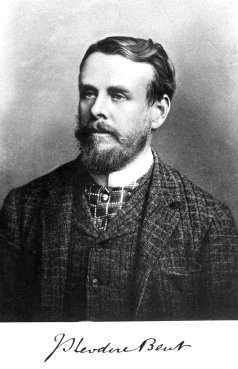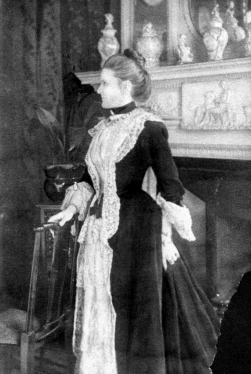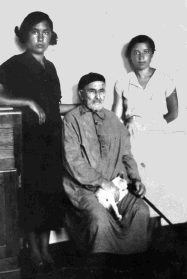With Theodore and Mabel Bent in southern Arabia (1893-1897)
Gerald Brisch
This article marks the publication this year of TheTravel Chronicles of Mrs J. Theodore Bent. Volume III: Southern Arabia and Persia: Mabel Bent's diaries of 1893-1898, from the archive of the Joint Library of the Hellenic and Roman Societies, London. Edited and introduced by Gerald
Brisch. Archaeopress, Oxford. ISBN 9781905739134.
Theodore and Mabel Bent married in 1877; he was then 25 and she some five years older. They were to form a close, if childless, partnership through many shared journeys of travel and exploration, financed largely from their own resources. Their first notable excursion was to Greece and the Cyclades in 1882-84. Theodore, assisted by his wife, made detailed notes on the history, archaeology and anthropology of theAegean islands which provided material for a successful book:
The Cyclades, or Life Among the Insular Greeks (1885). As travelogue and record of local tradition this account is still unsurpassed in English. During the next few years the Bents turned their attention to Asia Minor, and briefly, in 1889, to Bahrain and Persia. Theodore's excavation of burial mounds in Bahrain was partly inspired by ancient theories that the island was the early home of the Phoenicians. He was also impressed by the speculation that the Phoenicians, having migrated to Southern Africa, had founded 'Great Zimbabwe' in
Mashonaland, and that this once great city was in some way linked to the legend of King Solomon and the Queen of Sheba. So in 1891 Theodore embraced the opportunity of mounting an expedition to excavate the ruins of 'Great Zimbabwe'. This was to be at the joint expense of the British South Africa Company and the Royal Geographical Society, and proved a pivotal moment inTheodore's career as explorer and archaeologist.

|
Theodore Bent. Portrait by Lafayette. Private collection. |
All the couple's researches after their trip to Mashonaland were linked to Theodore's studies and theories of early communication between civilisations existing west and east of the Red Sea. In 1893 the Bents undertook a hazardous four month journey in north eastern Ethiopia reaching the ancient city of Aksum in their search for (Sabaean) inscriptions which might link 'Great Zimbabwe' to the old trade routes leading to Egypt and Southern Arabia. Their journey home was via Aden where Theodore's discussions at the British Residency encouraged him to make plans to visit Mukalla and the interior of Hadhramaut in the winter of 1893.
 |
Mabel Bent. An anonymous society portrait. Private collection |
Back in London, in a lecture to the British Association for the Advancement of Science, Theodore announced that he had found in Zimbabwe and Ethiopia the remains of a Sabaean civilisation which had come over from Southern Arabia and had moved down the east coast of Africa. He hoped soon, he said, to be able to 'reconstruct the history of a once mighty commercial race, which was contemporaneous with the best days of Egypt, Greece and Rome and which provided the ancient world with most of its most valued luxuries'.
Theodore's past disinclination to seek Ottoman clearance for his explorations in Asia Minor had embarrassed British consular officials, and had tarnished his reputation within the Foreign Office. When he sought permission to mount an expedition to Southern Arabia, the damaging Foreign Office view that he was 'neither discreet nor altogether trustworthy' was passed to the India Office. Permission was initially refused on the grounds that:
'in the present disturbed state of Arabia no countenance or assistance should be given by the authorities at Aden to British travellers to enable them to visit the interior. Such visits would not be sanctioned by theTurkish government which has repeatedly complained of the presence of Englishmen in the country'.
However, Theodore was able to enlist the support of the Director of the Royal Botanic Gardens, Kew, and the President of the Royal Geographical Society (RGS) to lobby British officialdom on his behalf and to emphasise the potential scientific dividends of his proposed expedition. Meanwhile, Theodore confirmed that he had no intention of travelling in or near Ottoman-occupied Yemen. Whitehall eventually relented, arrangements for the expedition were completed and the Bents arrived in Aden in December 1893. But the expedition got off to an inauspicious start. Theodore, who had been assured of official support by the Assistant Resident, Colonel Stace, when he visited Aden at the beginning of the year, found the Resident, Brigadier-General Jopp, thoroughly disobliging. He and Mabel regarded Jopp's attitude as a major slight towards them and the prestigious institutions which they represented. Instead of the substantial help which he was anticipating (and no doubt felt was due to him and Mabel for their work in Africa), the expedition only received brief letters of introduction to the local authorities in Mukalla. The slight is referred to frequently by Mabel in her chronicle and it clearly rankled. In a letter to the Secretary of the RGS, Scott Keltie, Theodore wrote:
'I cannot make out why it is but I have never in my life been treated by authorities so rudely as I have been at Aden. Col. Stace has unfortunately gone to India and people here seem amazed with him for having imported such troublesome people as ourselves. Gen. Jopp absolutely refuses to endorse Stace's promise of lending rifles, and as for the gunboat there is no thought of it and I have to pay £40 to get to Maculla next Friday. All he has done and all he will do is to give us 2 short letters to the Sheikhs of Maculla and
Shehr, according to instructions from home. He would 28 Mabel Bent. An anonymous society portrait. Private collection not see me for 2 days after our arrival and then in half an hour he managed to be as insolent as he could be ...'
Despite not being given the assistance he was expecting, Theodore decided to proceed with the expedition. Its members formed the largest party which he and Mabel had ever travelled with. In addition to them and their faithful Greek servant, Matthaios, it included a senior Indian surveyor, Imam Sharif, loaned by the Government of India together with three assistants for mapping;a young botanist from Kew, William Lunt, for plant collecting; an Egyptian, Mahmoud Bayoumi, from the British Museum's Natural History section; and an interpreter recommended by a member of the Aden Residency's Arab staff but whose obstreperous behaviour proved 'a constant source of difficulty and danger'.
 |
The Bents’ devoted Greek factotum and friend, Matthaios Simos, in old age. Photograph © Andreas Michalopoulos 2010. |
A few months before the Bents arrived in Southern Arabia, a German scholar, Leo Hirsch, reached Wadi Hadhramaut in search of Himyaritic inscriptions. He wasthe first European to penetrate so far inland. Although the Bents followed, Mabel could justly claim to be the first European woman to visit the Wadi (preceding Doreen Ingrams who went there in 1934, and Freya Stark in 1935).
The Royal Botanic Gardens (RBG) hold in their archives a fascinating volume relating to the Bents' 1894 expedition. This includes a copy of Lunt's journal and lists of specimens collected. The RBG also hold a number of letters from Mabel and Theodore Bent in their files of 'Directors' Correspondence'. The plants sent to Kew by the Bents are recorded in the RBG 'Plant Determination Lists for Arabia and Nubia'. Actual specimens collected by Lunt in the Hadhramaut are also held in the Kew Herbarium.
The zoological collections were more limited but specimens sent to London included some creatures described as being 'new to science'.
The Bents' devoted Greek factotum, Matthaios Simos, from the Cycladic island of Anafi, is mentioned in Mabel's South Arabian chronicles. The Bents had met him on Naxos during the winter of 1883-4, and they had engaged his services on most of their later journeys. He is encountered again in Mabel's diaries for 1897, when he plays a part in saving her life. Matthaios later settled with his young family in Athens where today his descendants still live.
Mabel used two notebooks to chronicle the couple's travels to the Hadhramaut in 1893-4. The first includes the party's preparations in Aden (December 1893) and subsequent sea voyage to Mukalla. Mabel then details their slow progress inland to Al-Koton (al-Qatn) in Wadi Hadhramaut, which becomes their base for a month while they try to arrange guides to take them into Wadi Masila and down to Sayhut on the southern coast. When this fails, she chronicles their shorter journey (March 1894) to Sheher (Shihr). The second notebook continues with their short exploration east along the coast to Kossair (Qusa'ir) before returning to 30 Shihr, whence they take ship via Mukalla for Aden and the long journey home.
On this trip, as on previous expeditions, Theodore was a keen sketcher while Mabel assumed the role of expedition photographer, carrying with her all the materials and equipment she would need for developing during her travels. Her diary contains frequent accounts of the difficulties she faced as a pioneer in this field. Unfortunately only a very few of her images have survived. Some feature in
Southern Arabia which was written up by Mabel from Theodore's journals and her own for publication in 1900, three years after Theodore's death. Other images feature in Theodore's monographs and articles or appeared in the form of presentation slides which Mabel prepared for her husband's lectures. At these Theodore also exhibited some of his small assemblage of archaeological finds. A number of the latter were acquired by the British Museum where they join his other finds from the eastern Mediterranean and Africa.
At the end of 1896 the Bents paid a further visit to the region, spending two months in
Soqotra. They then returned to Aden and in February 1897 travelled north east to territory inhabited by the Fadhli and Yafa'i tribes. During this
trip Theodore was struck down by malaria. He later contracted pneumonia and died in May 1897 a few days after their return to England. Mabel lived on until 1929.

|
Agreement to transport the Bents and their party by boat from Soqotra to Aden. Signed in the presence of Sultan Salim bin Hamad bin Sa’ad bin Afrar, Ruler of Soqotra, and dated Ramadhan 1314 H (February 1897). Reproduced with the kind permission of the Hellenic Society and the Joint Library of the Hellenic and Roman Societies. |
